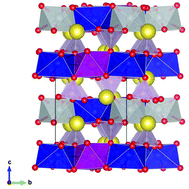Synthesis, and crystal and electronic structure of sodium metal phosphate for use as a hybrid capacitor in non-aqueous electrolyte
Abstract
Energy storage devices based on sodium have been considered as an alternative to traditional lithium based systems because of the natural abundance, cost effectiveness and low environmental impact of sodium. Their synthesis, and crystal and electronic properties have been discussed, because of the importance of electronic conductivity in supercapacitors for high rate applications. The density of states of a mixed sodium transition metal phosphate (maricite, NaMn1/3Co1/3Ni1/3PO4) has been determined with the ab initio generalized gradient approximation (GGA)+Hubbard term (U) method. The computed results for the mixed maricite are compared with the band gap of the parent NaFePO4 and the electrochemical experimental results are in good agreement. A mixed sodium transition metal phosphate served as an active electrode material for a hybrid supercapacitor. The hybrid device (maricite versus carbon) in a non-aqueous electrolyte shows redox peaks in the cyclic voltammograms and asymmetric profiles in the charge–discharge curves while exhibiting a specific capacitance of 40 F g−1 and these processes are found to be quasi-reversible. After long term cycling, the device exhibits excellent capacity retention (95%) and coulombic efficiency (92%). The presence of carbon and the nanocomposite morphology, identified through X-ray photoelectron spectroscopy (XPS) and transmission electron microscopy (TEM) studies, ensures the high rate capability while offering possibilities to develop new cathode materials for sodium hybrid devices.


 Please wait while we load your content...
Please wait while we load your content...